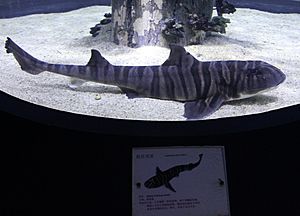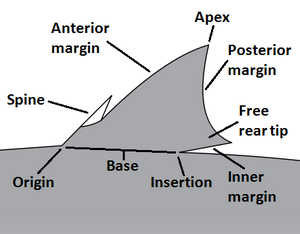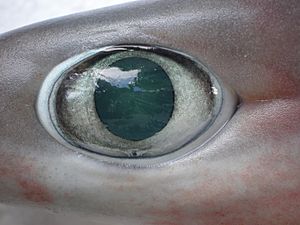Shark facts for kids
- For the NHL team, see San Jose Sharks
Quick facts for kids Sharks |
|
|---|---|
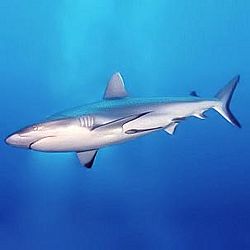 |
|
| Grey reef shark (Carcharhinus amblyrhynchos) | |
| Scientific classification | |
| Kingdom: | |
| Phylum: | |
| Class: | |
| Subclass: | |
| Superorder: |
Selachimorpha
|
Sharks are a special group of fish called Selachimorpha. Unlike most fish, their skeletons are made of cartilage, not bone. Cartilage is a strong, bendy material, like what's in your nose or ears. Other fish with cartilage skeletons include skates and rays.
There are over 350 different kinds of sharks. Some famous ones are the great white shark and the huge whale shark. Scientists have found fossils showing that sharks have been around for about 420 million years. That's a very long time!
Most sharks are predators. This means they hunt and eat other sea creatures. They eat fish, marine mammals, and more. But the biggest shark, the whale shark, eats tiny krill, just like some whales. The whale shark is actually the largest fish in the world! Other common sharks you might know are the hammerhead shark, tiger shark, and mako shark.
Contents
Amazing Shark Features
Sharks come in many shapes and sizes. Most are long and sleek, built for swimming fast. They have powerful jaws. One cool thing about sharks is that their teeth are always being replaced. Sharks often break teeth when they eat. New teeth constantly grow in their mouth, moving forward like a "conveyor belt." A shark can lose and regrow up to 30,000 teeth in its lifetime!
Even with all those teeth, sharks can't chew their food. They bite their prey and shake it to tear off chunks. These chunks go into their stomach to be digested. This process is slow, so a shark might not need to eat every day.
Shark teeth look different depending on what they eat. Some sharks have sharp, pointy teeth for catching fish. Sharks that live on the seabed have cone-shaped teeth for crushing shells. Many people enjoy collecting shark teeth because they are so varied. You can even guess how big a shark was by measuring its tooth! For every inch a tooth is long, the shark was about 10 feet long. Imagine, some Megalodon teeth are 6 inches long, meaning those sharks were 60 feet long!
A shark's skin is covered in millions of tiny, tooth-like scales. These scales point towards the tail. If you rub a shark from head to tail, it feels smooth. But if you rub the the other way, it feels rough, like sandpaper.
Shark Fins
Sharks use their fins to stay balanced, steer, get lift, and swim. Each fin has a special job.
Sharks have one or two fins on their back, called dorsal fins. These fins help stop the shark from rolling over. Some dorsal fins have spines that can be used for defense. These spines might even have glands that release an irritating substance.
The pectoral fins are located behind the shark's head and stick out to the sides. They help the shark steer while swimming and provide lift, keeping the shark from sinking.
The pelvic fins are behind the pectoral fins and also help with stability.
Not all sharks have anal fins. If they do, these fins are found between the pelvic fins and the tail fin.
The tail area includes the caudal peduncle and the caudal fin. The caudal fin is the main engine for swimming. It pushes the shark forward. The upper part of the tail fin usually pushes the shark downwards, but the pectoral fins and the shark's body shape help to balance this force. Sharks that live near the seabed, like the Nurse shark, have strong, non-crescent-shaped tail fins. The fastest sharks, like Mako sharks, have crescent-shaped (lunate) tail fins.
Amazing Shark Senses
Incredible Sense of Smell
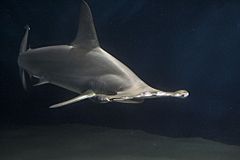
Sharks have an amazing sense of smell. They can detect tiny amounts of blood in the water from miles away. Even a tiny bit of blood, like one part per million, is enough for them to notice.
Sharks can even tell which direction a smell is coming from. They do this by sensing when the smell reaches each nostril. This is similar to how humans figure out where a sound comes from using both ears.
Some sharks, like nurse sharks, have special whiskers called barbels near their mouths. These barbels help them find prey even better.
Sharp Eyesight
Shark eyes are similar to human eyes, with lenses, corneas, and retinas. Their eyesight is perfect for the ocean environment. Unlike most fish, sharks can make their pupils bigger or smaller, just like humans can. They also have a special tissue behind their retina that reflects light, helping them see better in dark waters.
Sensing Electric Currents
Sharks have tiny holes all over their snout, especially between the eye and the tip of the snout. These holes contain special nerve receptors called ampullae of Lorenzini. These receptors can sense electricity in the water. Every time an animal's heart beats or it moves, it creates tiny electric currents. Sharks can pick up these signals. They might use this sense to find their prey, even more than they use their sight.
Good Hearing
It's hard to test a shark's hearing, but they likely have a very good sense of hearing. They might be able to hear prey many miles away. A small opening on each side of their heads leads directly to their inner ear.
The Lateral Line
Sharks also have a lateral line system. This system detects changes in water pressure, like vibrations or movement. It's a line of pores along their body that is open to the water. This sense helps the shark detect other fish or objects moving nearby, even in the dark. Sharks can sense frequencies from 25 to 50 Hz.
Ancient Sharks
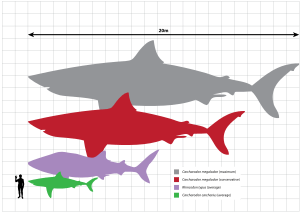
Because shark skeletons are made of cartilage, they don't turn into fossils easily. Cartilage is softer than bone and usually breaks down before it can fossilize. However, shark teeth are very hard, and sharks shed them throughout their lives. This is why shark teeth are some of the most common fossils found.
Sharks existed for at least 200 million years before the dinosaurs even appeared! The earliest shark fossils were just scales. We don't know if these early sharks had teeth. Early sharks also looked different from modern sharks. For example, in modern sharks, the upper snout is longer than the lower jaw. But in early sharks, both were the same length.
The first sharks that looked like modern sharks appeared during the Age of Dinosaurs. Back then, giant sea reptiles sometimes hunted sharks.
Just a few million years ago, a huge shark called Megalodon swam in the seas. It was about 18 meters (60 feet) long! That's twice as long as a great white shark. Megalodon ate whales and other large marine animals. It died out about 1.6 million years ago.
Shark Reproduction
About 70% of all known shark species give birth to live young. The time they are pregnant can last from 6 to 22 months.
Baby sharks, called pups, are born with a full set of teeth. They can take care of themselves right away. Once born, they quickly swim away from their mothers. The number of pups in a litter can vary a lot. Some sharks, like the Great white shark, have only one or two pups. Others, like the Blue shark and Whale shark, can have up to one hundred pups!
Oviparity (Egg-laying)
Some sharks are oviparous, meaning they lay their eggs in the water. Shark eggs are sometimes called "mermaid's purses." They are covered by a tough, leathery casing. Inside, the egg has a yolk that feeds the baby shark, much like a chicken egg.
Ovoviviparity (Eggs Hatch Inside)
Most sharks are ovoviviparous. This means the eggs hatch inside the female's body. The babies develop inside the mother, but there's no placenta to feed them. Instead, the young sharks feed on the egg's yolk. Sometimes, the pups even eat unfertilized eggs or other pups inside the mother! Because of this, very few pups in a litter survive until birth. Examples of sharks that reproduce this way include Great white sharks, Mako sharks, Nurse sharks, Tiger sharks, and Sand tiger sharks.
Viviparity (Live Birth)
Some sharks are viviparous. This means the females give live birth, similar to mammals. The eggs hatch inside the female's body, and the babies are fed by a placenta. The placenta helps transfer nutrients and oxygen from the mother to the baby and removes waste. Examples of viviparous sharks include Bull sharks, Whitetip reef sharks, Lemon sharks, Blue sharks, Silvertip sharks, and Hammerhead sharks. For a long time, people thought Whale sharks laid eggs, but now we know they are viviparous. Pregnant female whale sharks have been found with hundreds of pups inside them!
New Shark Discoveries
Scientists are still finding new kinds of sharks! Dave Ebert, a scientist, has found ten new species just in a Taiwan market. Over the past 30 years, he has named 24 new species. These include sharks, rays, sawfish, and ghost sharks. All these fish are related because they have cartilage skeletons.
Sharks and Fishing
Some shark species are not endangered, but others are hunted for food or for sport. Shark fin soup is a dish made from shark fins. In 2013, five types of sharks, along with two types of manta ray, received international protection. This was part of the Convention on International Trade in Endangered Species.
It's estimated that about 100 million sharks are killed each year by commercial and recreational fishing. Sharks are a common seafood in many places, like Japan and Australia.
In Victoria, Australia, shark meat is the most common fish used in fish and chips. It's often called "flake" in fish and chip shops.
In India, small sharks or baby sharks are sold in local markets. In the Tamil language, they are called sora. The soft bones can be easily chewed. This dish is considered a special food in coastal Tamil Nadu.
Related Pages
Images for kids
-
A collection of Cretaceous shark teeth
-
Shark fossil, Lebachacanthus senckenbergianus, from the Permian period
-
The teeth of tiger sharks are oblique and serrated to saw through flesh
-
The dermal denticles of a lemon shark, viewed through a scanning electron microscope
-
The claspers of male spotted wobbegong -
Unlike many other sharks, the great white shark is not actually an apex predator in all of its natural environments, as it is sometimes hunted by orcas
-
A sign warning about the presence of sharks in Salt Rock, South Africa
-
Snorkeler swims near a blacktip reef shark. In rare circumstances involving poor visibility, blacktips may bite a human, mistaking it for prey. Under normal conditions they are harmless and shy.
-
Shark-themed nose art, made popular by the Flying Tigers (pictured), is commonly seen on military aircraft.
See also
 In Spanish: Tiburones para niños
In Spanish: Tiburones para niños


